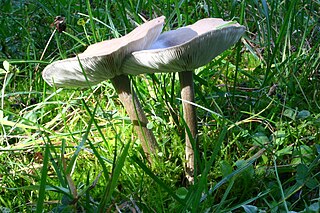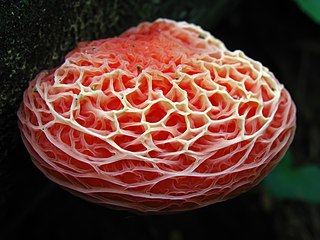
Clitocybe is a genus of mushrooms characterized by white, off-white, buff, cream, pink, or light-yellow spores, gills running down the stem, and pale white to brown or lilac coloration. They are primarily saprotrophic, decomposing forest ground litter. There are estimated to be around 300 species in the widespread genus.

Boletus is a genus of mushroom-producing fungi, comprising over 100 species. The genus Boletus was originally broadly defined and described by Carl Linnaeus in 1753, essentially containing all fungi with hymenial pores instead of gills. Since then, other genera have been defined gradually, such as Tylopilus by Petter Adolf Karsten in 1881, and old names such as Leccinum have been resurrected or redefined. Some mushrooms listed in older books as members of the genus have now been placed in separate genera. These include such as Boletus scaber, now Leccinum scabrum, Tylopilus felleus, Chalciporus piperatus and Suillus luteus. Most boletes have been found to be ectomycorrhizal fungi, which means that they form a mutualistic relationship with the roots system of certain kinds of plants. More recently, Boletus has been found to be massively polyphyletic, with only a small percentage of the over 300 species that have been assigned to Boletus actually belonging there and necessitating the description and resurrection of many more genera.

Melanoleuca is a poorly known genus of saprotrophic mushrooms traditionally classified in the family Tricholomataceae. Most are small to medium sized, white, brown, ocher or gray with a cylindrical to subcylindrical stipe and white to pale yellowish gills. The basidiospores are ellipsoid and ornamented with amyloid warts. Melanoleuca is considered a difficult group to study due to their macroscopic similarities among species and the need of a thorough microscopic analysis to separate species. DNA studies have determined that this genus is closely related to Amanita and Pluteus and that it does not belong to the family Tricholomataceae.

The Mycenaceae are a family of fungi in the order Agaricales. According to the Dictionary of the Fungi, the family contains 10 genera and 705 species. This is one of several families that were separated from the Tricholomataceae as a result of phylogenetic analyses. Taxa in the Mycenaceae are saprobic, have a cosmopolitan distribution, and are found in almost all ecological zones. The family was circumscribed by Caspar van Overeem in 1926.

Rhodotus is a genus in the fungus family Physalacriaceae. There are two species in the genus with the best known, Rhodotus palmatus, called the netted rhodotus, the rosy veincap, or the wrinkled peach. This uncommon species has a circumboreal distribution, and has been collected in eastern North America, northern Africa, Europe, and Asia; declining populations in Europe have led to its appearance in over half of the European fungal Red Lists of threatened species. Typically found growing on the stumps and logs of rotting hardwoods, mature specimens may usually be identified by the pinkish color and the distinctive ridged and veined surface of their rubbery caps; variations in the color and quantity of light received during development lead to variations in the size, shape, and cap color of fruit bodies.
Arthrosporella is a fungal genus in the family Tricholomataceae. It is a monotypic genus, containing the single species Arthrosporella ditopa, found in South America. The genus was described by mycologist Rolf Singer in 1970.
Austroomphaliaster is a fungal genus in the family Tricholomataceae. It is a monotypic genus, containing the single species Austroomphaliaster nahuelbutensis, also known as the Big Puma Mushroom, Austroomphaliaster nahuelbutensis was found in temperate South America. This species lived on Patagonian Oak Trees and Dombey’s Beech Tree. This species hasn’t been seen in 35 years and is part of Re:wild’s Search For Lost Species Initiative. In May 2023, specimens have been found which may be Austroomphaliaster nahuelbutensis, but DNA analysis is still needed to confirm the identity.

Delicatula is a genus of fungi in the family Tricholomataceae. It was first described by Swiss mycologist Victor Fayod in 1889. The genus contains two widely distributed species.
Dennisiomyces is a genus of fungi in the family Tricholomataceae. Described by mycologist Rolf Singer in 1955, the genus contains five species found in South America.

Dermoloma is a genus of fungi in the family Tricholomataceae. The widespread genus contains about 15 species.

Gamundia is a genus of fungi in the family Tricholomataceae. The genus contains six species found in Europe and temperate regions of South America.

Mycenella is a genus of fungi in the family Tricholomataceae. The widespread genus contains 10 species, found mostly in temperate regions. Mycologist Rolf Singer circumscribed the genus in 1938.
Porpoloma is a genus of fungi in the family Tricholomataceae. The genus contains about 12 species found predominantly in South America. Porpoloma was described by mycologist Rolf Singer in 1952 with P. sejunctum as the type species.

Pseudoclitocybe is a genus of fungi in the family Pseudoclitocybaceae. The genus contains about ten species with a collectively widespread distribution.

Pseudoomphalina is a genus of fungi in the placed in the family Tricholomataceae for convenience. The genus contains six species that are widespread in northern temperate areas. Pseudoomphalina was circumscribed by Rolf Singer in 1956. Pseudoomphalina was found to be paraphyletic to Neohygrophorus in a molecular phylogenetics study and since Pseudoomphalina is an older name, Neohygrophyorus was synonymized with it. The type species of Neohygrophorus was Neohygrophorus angelesianus, now Pseudoomphalina angelesiana. In earlier classifications based on anatomy prior to DNA sequence-based classifications, its unusual combination of features led taxonomists to independently create two subgenera in two genera: Hygrophorus subg. Pseudohygrophorus and Clitocybe subg. Mutabiles; the latter based on Neohygrophorus angelesianus but described under a new species name which is now placed in synonymy, Clitocybe mutabilis. All species of Pseudoomphalina are united by the presence of clamp-connections in their hyphae, an interwoven gill trama and amyloid spores. Pseudoomphalina angelesiana possesses grey-violaceous pigments that turn red in alkali solutions and lacks filiform, hyphal sterile elements in its hymenium and stipitipellis. These were features used to distinguish it from Pseudoomphalina as a genus, but Pseudoomphalina umbrinopurpurascens possesses these same pigments and the filiform elements of Pseudoomphalina. Molecular phylogenetics studies have also found some former species of Pseudoomphalina to belong in other genera. Pseudoomphalina pachyphylla was moved to its own genus, Pseudolaccaria, and Pseudoomphalina clusiliformis was synonymized with it. Pseudoomphalina flavoaurantia and Pseudoomphalina lignicola were found to belong in Clitocybula. Phylogenetically, Pseudoomphalina is in a tricholomatoid clade but not in the Tricholomataceae.

Clitocybula is a genus of mushroom-forming fungi in the family Porotheleaceae but was originally classified within Marasmiaceae. The genus was circumscribed by Georges Métrod in 1952. Species in the genus are commonly known as "coincaps".
Lulesia densifolia is a species of fungus that was first described by Rolf Singer in 1970. It is the type species of the genus Lulesia. As with the other two species in this genus, L. densifolia is found in the tropics.

Lentinula lateritia is a species of agaric fungus in the family Omphalotaceae. It is found in South-east Asia and Australasia, except for New Zealand. Originally described by Miles Joseph Berkeley in 1881 as a species of Agaricus, it was transferred to the genus Lentinula in 1983 by David Pegler.













